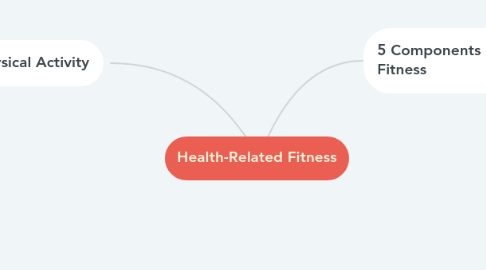
1. Our Ancestors & Physical Activity
1.1. Identify and describe 3-5 differences between modern day and historic lifestyles as it relates to physical activity.
1.1.1. In the past, people did not have cars, so they had to walk everywhere they went. Today, most people drive everywhere they go and even try to park as close as possible to avoid walking.
1.1.2. In the past, people's jobs were much more physical, they did not have desk jobs or machines to make jobs easier. Today, many people jobs require them to sit the whole day. Some jobs have machines that do most of the physical labor, for example, trash trucks and cranes for construction.
1.1.3. In the past, there was no "fast food." For much of history, people had to hunt and gather food which required a lot of physical activity. The Native Americans are an example of people who lived like this. Today, it is very common for people to obtain food without exerting any physical energy.
2. 5 Components of Health-Related Fitness
2.1. 1. Strength
2.1.1. What is it?
2.1.1.1. "Muscular strength is the amount of force you can put out or the amount of weight you can lift."
2.1.2. Benefits of Strength
2.1.2.1. Same as ME (below)
2.1.3. Activities that Improve Strength
2.1.3.1. Same as ME, except lifting weights in the 1-5 repetition range.
2.2. 2. Muscular Endurance (ME)
2.2.1. What is it?
2.2.1.1. "Muscular endurance is how many times you can move that weight without getting exhausted (very tired)."
2.2.2. Benefits of ME
2.2.2.1. - Increase your ability to do activities like opening doors, lifting boxes or chopping wood without getting tired. - Reduce the risk of injury. - Help you keep a healthy body weight. - Lead to healthier, stronger muscles and bones. - Improve confidence and how you feel about yourself.
2.2.3. Activities that Improve ME
2.2.3.1. Resistance training: Equipment like medicine balls or weight machines. Resistance tubes or bands during exercises. Your own body as a weight, as you would do during push-ups or sit-ups
2.3. 3. Cardiovascular Endurance (CE)
2.3.1. What is it?
2.3.1.1. "the body’s ability to continue exertion while getting energy from the aerobic system used to supply the body with energy."
2.3.2. Benefits of CE
2.3.2.1. "Endurance activity keeps your heart, lungs and circulatory system healthy and improves your overall fitness. As a result, people who get the recommended regular physical activity can reduce the risk of many diseases such as diabetes, heart disease and stroke."
2.3.3. Activities that Improve CE
2.3.3.1. Running, jogging, walking briskly, swimming, biking, soccer, basketball, tennis, etc.
2.4. 4. Flexibility
2.4.1. What is it?
2.4.1.1. "Flexibility training includes stretching exercises for the purpose of increasing one’s range of motion."
2.4.2. Benefits of Flexibility
2.4.2.1. "Flexibility exercises can increase the range of motion throughout a joint. Increased range of motion can improve mobility in sporting events as well as everyday activities. Proper range of motion in the joints allows for the natural alignment of the body to be maintained throughout the day, which may prevent or decrease pain or injury."
2.4.3. Activities that Improve Flexibility
2.4.3.1. Stretching, yoga
2.5. 5. Body Composition
2.5.1. What is it?
2.5.1.1. "Body composition is a measurement of a person’s fat mass and fat-free (lean) mass." "Body composition is one of the best indicators of overall health."
2.5.2. Benefits of Healthy Body Composition
2.5.2.1. “It can decrease your risk for cardiovascular disease, diabetes, metabolic disease, osteoporosis, and other diseases," and "improve ability to perform day-to-day activities, increase energy, and help maintain cognitive function and decrease stress."
2.5.3. Activities that Improve Body Comp.
2.5.3.1. "Physical activity paired with a healthy diet can help you lose weight and achieve a body composition that’s healthy for you. Even moderate exercise—30 minutes most days of the week—can bring big health benefits."

